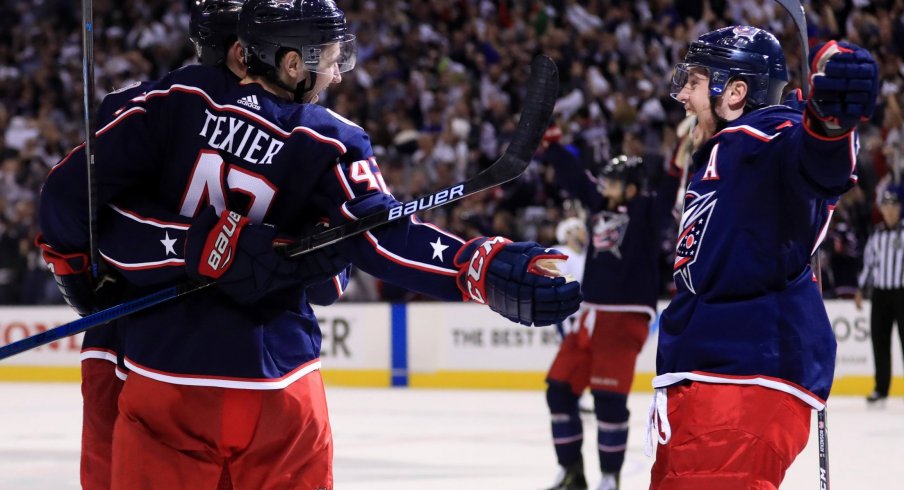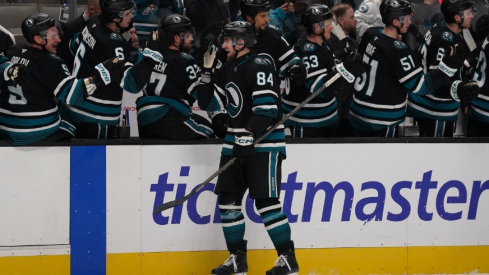You can already hear the "SHOOOOOOT" screams, can't you?
This is a common bark by folks around Nationwide Arena when the Columbus Blue Jackets have been on the man-advantage in the past few seasons, if not for a lot of the course of their franchise. Why is this?
The obvious reason being that fans believe the Blue Jackets to not be shooting the puck enough on the power play, thinking the team would rather focus on passing in circles than score a goal. This criticism has been mostly unfair (and a little too repetitive) for most of the years of the franchise, but in recent years, the team's rope of slack is running short.
Last season, Columbus had the fourth-worst power play in the NHL, and it wasn't a problem that came out of nowhere. The past two seasons, they've had statistically the worst man-advantage efficiency in the league.
For an organization that ranks third in the NHL in points over the course of the past three seasons...something doesn't add up here. The Blue Jackets haven't just been able to put the neck on the power play, it's seemed like a struggle for them to even try and set up their system before the player in the opposing penalty box's time is up.
This was a problem, even with world-class forward Artemi Panarin lining up on the left hash. Clearly, then, the level of talent wasn't the issue. It was an issue surrounding the formation and combination of players.
Panarin and Matt Duchene, two of the five players on the top power play unit last season are gone. Younger players like Alexandre Texier and Emil Bemstrom are penciled in to get some minutes on the man advantage as well as newcomer Gustav Nyquist. It's a new era for the Blue Jackets on the power play.
#CBJ PP units today:
— Brian Hedger (@BrianHedger) October 2, 2019
1 ->
Foligno
Bemstrom - Anderson - Atkinson
Jones
2 ->
Wennberg
Texier - Nyquist - Bjorkstrand
Werenski
Is this overhaul of personnel a good thing? Let's breakdown the new faces on each unit.
THE SUCCESSFUL VERSION OF THE POWER PLAY
The only time "successful" and "power play" have been in the same sentence regarding the Blue Jackets over the past few years has been, of course, in the most important part of the season - the playoffs.
Against the Tampa Bay Lightning this past postseason, the Blue Jackets were 50% on the power play (5-10) after an abysmal 15.38% during the regular season. What caused the drastic change for the club in their efficiency?
Seth Jones
Jones isn't a new face, but according to the practice lines, he will be a new face to the top power play unit.
Even when Jones was on the second power play unit for the Blue Jackets in the postseason, he was on the ice for four of the five man-advantage goals in the Lightning series, tallying 1-2-3 in the process. His vision and dictation of play from the top in a 1-3-1 format is second-to-few.
Emil Bemstrom
Bemstrom's bomb of a slapshot goal in his first preseason game was encouraging, even if he had a quiet remainder of the preseason. Bemstrom is looking to take on the 2017-2017 Sam Gagner role of a fourth-line winger that gets featured on the power play, which should be a good way to test the waters with what Bemstrom really has to offer.
Josh Anderson
Anderson so some time on the second unit sparingly last year, but his huge body to draw traffic in the slot has earned him first unit honors (for now). He has the potential to cause fits for opposing teams in causing screens for goaltenders and wacking home rebounds.
Bemstrom blowing out your speakers pic.twitter.com/NiQpz2YJOj
— Columbus Blue Jackets (@BlueJacketsNHL) September 17, 2019
Gustav Nyquist
Nyquist has proven in his career to be a viable scorer and playmaker, on the power play and at even strength. He had 12 power play points last season, ten of which were assists. A Werenski to Nyquist to Texier/Bjorkstrand one-timer could be a lot of fun to watch.
Alexander Wennberg
A 59-point player two seasons ago diminished to a two-goal-scorer last year but has shown tremendous signs of a comeback campaign. Having Wennberg down low to work the puck and feed Bjorkstrand and Texier one-timers from behind the net just might be crazy enough to work.
THE DISAPPOINTING VERSION OF THE POWER PLAY
This is an easier conversation to have and convince yourself of because it's what we've been used to seeing for over two years now. A disappointing version of a power play, featuring the Columbus Blue Jackets, has become a commonality.
The problem, again, wasn't necessarily talent (Panarin ripping one-timers from the left circle isn't bad to have on your team) but now that he's gone, along with Duchene, should we be concerned about the level of talent dipping?
Not to mention the Blue Jackets power play scraped together 34 goals during the 2018-2019 regular season, fourth-lowest in the league, and Panarin contributed to more than half of those (six goals, 12 assists). Now he's gone.
With that much production being lost on an already-poor man advantage, what can we even expect results to look like now?
Seth Jones
There's not much to critique about Jones' play or any potential pitfalls he could run into. He did only score nine goals last year, which for a Norris-Trophy candidate, isn't quite up too par. Werenski is certainly quicker on the offensive end, which could make a case to swap for Jones if he shows signs of not being able to move the puck fast enough. That is a pipe dream for opposing teams, though - Jones should be fine.
Emil Bemstrom
This is essentially the artificial replacement of Panarin, a 20-year-old who has never played in an NHL regular season game. Bemstrom was fun to watch in the SHL, but when he has NHL-level goaltenders sliding over to contest his one-timers, will he find nearly as much success?
Josh Anderson
Anderson is a freight train with breaking to the net and working in open space, but that may be where a problem lies. There's not that much space on a power play. Sure, entering the zone requires speed, but you also need to settle the puck and work it around to get the defense and goalie moving. Does Anderson have the hands, patience and composure to slow his play down and move the puck?
Gustav Nyquist
Nyquist found success as a power play force last season, but he is 30-years-old, and his enhanced play a year ago could have been due to the fact that he was in a contract year. In the previous two seasons before last combined, he only had 17 total power play points, which for a 50-60 point-getter, is a little discouraging. Perhaps a change of scenery will help spark his play on the man advantage, but, what if we're already seeing Nyquist's regression?
Alexander Wennberg
What if Wennberg can't find his old self again? If his confidence shrinks, opposing defenders will pounce on him and force consistent turnovers below the goal-line. His passing has always been a strong suit of his game, but if he doesn't take a shot every once in a while, will he be any sort of threat?
There's nowhere to go but up, right? This is the hope for a power play that has been frustratingly mediocre since 2017 - one that could be a huge catalyst to a fourth-consecutive playoff birth for the team should it find some consistency.
With all the new faces on the man advantage, we're either in for a thrilling surprise and change of character or a worse version of something that was already unbearable to watch.


